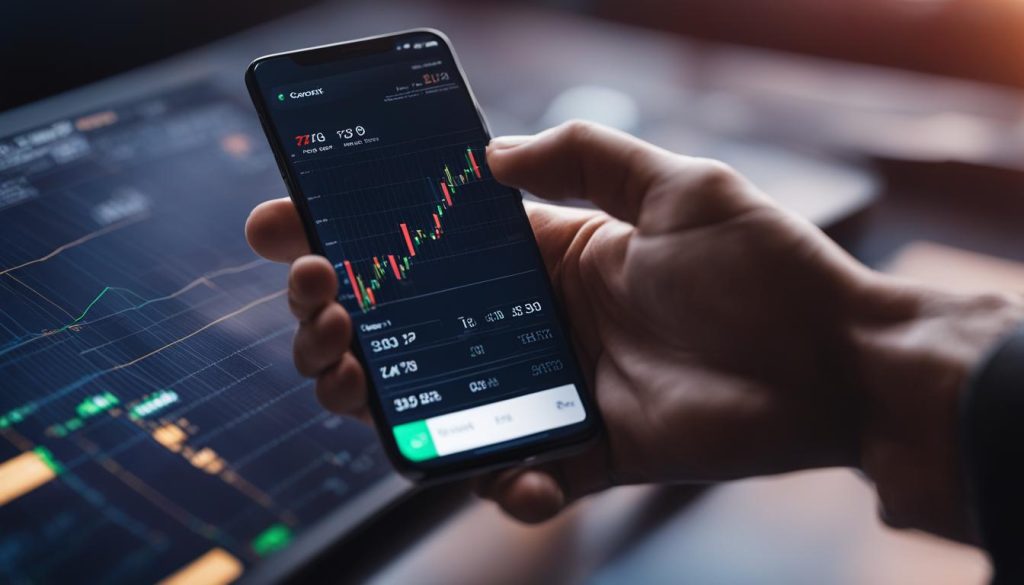The world of cryptocurrency has experienced explosive growth in recent years, accompanied by significant fluctuations in crypto valuations. Understanding the concept of volatility in crypto, its causes and effects on the market, and strategies to mitigate the associated risks is crucial for investors.
Key Takeaways:
- Cryptocurrency price volatility is characterized by extreme fluctuations in the value of digital assets.
- Understanding volatility in crypto is essential for investors to manage price risks effectively.
- There are three types of volatility in the crypto market: historical, implied, and realized volatility.
- Various factors contribute to the volatility in the crypto market, including market sentiment, regulatory changes, and technological factors.
- To mitigate the risks associated with crypto price volatility, investors can employ volatility management strategies and analyze historical and real-time price volatility.
What is Volatility in Crypto and Why Does it Matter?
Understanding the concept of volatility in the cryptocurrency market is essential for investors looking to navigate the digital currency landscape. Volatility refers to the degree of fluctuation in cryptocurrency prices, and it plays a significant role in shaping market dynamics. Managing cryptocurrency price risks and mitigating volatility in the crypto market are crucial strategies for successful trading.
Volatility in digital assets is driven by various factors, including market sentiment, regulatory changes, liquidity, and technological advancements. These factors can cause prices to fluctuate rapidly, creating both opportunities and risks for investors. By understanding the drivers of volatility, investors can make informed decisions and develop strategies to manage the associated risks.
One of the main reasons why volatility in crypto matters is its impact on investment returns. High volatility can lead to significant price swings, presenting opportunities for traders to profit from short-term price movements. However, it also introduces greater risks, as prices can decline just as rapidly. Effective risk management is crucial to navigate these price fluctuations and protect investment capital.
Moreover, volatility in digital currency markets also affects market liquidity and adoption. Extreme price fluctuations can create uncertainty and hamper the widespread acceptance of cryptocurrencies as a medium of exchange. Therefore, understanding and managing volatility is not only important for individual investors but also for the overall growth and stability of the cryptocurrency ecosystem.

Impact of Volatility in Crypto:
Volatility in crypto can have both positive and negative effects on market participants. Here are some key implications of price volatility in digital currency:
- Investment Opportunities: High volatility can provide opportunities for traders to profit from short-term price movements, especially in fast-paced markets like cryptocurrencies.
- Increased Risk: Volatile price swings can lead to significant losses for investors who are not prepared to manage the associated risks.
- Market Manipulation: The high volatility in crypto markets can attract market manipulators who exploit price fluctuations for their own gain.
- Price Discovery: Volatility plays a crucial role in price discovery, as it helps determine the fair value of cryptocurrencies based on supply and demand dynamics.
- Market Liquidity: Extreme price fluctuations can impact market liquidity, making it challenging for investors to enter or exit positions at desired prices.
“Volatility is an inherent characteristic of the cryptocurrency market, and understanding its implications is essential for successful trading.” – Crypto Trader
Strategies for Managing Price Risks in Crypto:
To mitigate the risks associated with volatility in the crypto market, investors can employ various strategies:
- Diversification: Spreading investments across different cryptocurrencies and asset classes can help reduce the impact of price fluctuations on overall portfolio performance.
- Stop-Loss Orders: Setting stop-loss orders can automatically trigger the sale of a cryptocurrency if its price drops below a specified level, helping limit potential losses.
- Technical Analysis: Using technical indicators and chart patterns can help identify potential price reversals and entry/exit points in volatile market conditions.
- Staying Informed: Keeping up with the latest news, regulatory developments, and market trends can help investors anticipate potential price movements and make informed decisions.
- Long-Term Investment Approach: Taking a long-term investment approach can help mitigate the impact of short-term price fluctuations and focus on the underlying fundamentals of cryptocurrencies.
By understanding the nature of volatility in digital currencies and implementing appropriate risk management strategies, investors can navigate the crypto market with confidence and potentially capitalize on the opportunities it offers.
| Volatility Management Strategies | Benefits |
|---|---|
| Diversification | Reduces risk by spreading investments across different assets. |
| Stop-Loss Orders | Automatically triggers the sale of a cryptocurrency to limit potential losses. |
| Technical Analysis | Helps identify potential price reversals and entry/exit points. |
| Staying Informed | Keeps investors updated on market trends and regulatory developments. |
| Long-Term Investment | Focuses on the underlying fundamentals of cryptocurrencies. |
Types of Volatility in Crypto
In the cryptocurrency market, price fluctuations are a common occurrence. Understanding the different types of volatility can help investors make informed decisions and manage their risks effectively. There are three main types of volatility in the crypto market: historical volatility, implied volatility, and realized volatility.
Historical Volatility
Historical volatility measures the past price fluctuations of a cryptocurrency over a specific period. It provides insights into the asset’s price movements and helps investors assess the level of risk involved. Historical volatility is often represented using statistical indicators such as standard deviation or variance. By analyzing historical volatility, investors can identify patterns and trends, which can be useful for predicting future price movements.
Implied Volatility
Implied volatility, also known as market volatility, is derived from options prices. It reflects the market’s expectation of future price fluctuations. Implied volatility is calculated based on the demand and supply of options contracts for a particular cryptocurrency. High implied volatility indicates that investors anticipate significant price swings, while low implied volatility suggests a more stable market. Traders often use implied volatility to assess the market’s sentiment and make informed trading decisions.
Realized Volatility
Realized volatility measures the actual price fluctuations of a cryptocurrency within a specific timeframe. It is calculated based on the historical price data and provides a more accurate representation of price movements compared to implied or historical volatility. Realized volatility can help investors evaluate the performance of their investments and adjust their strategies accordingly. By analyzing realized volatility, traders can identify periods of high or low volatility and adjust their trading strategies accordingly.
Understanding the different types of volatility in the crypto market is essential for investors looking to navigate the volatile nature of cryptocurrencies. By analyzing historical, implied, and realized volatility, investors can gain insights into price fluctuations and make informed decisions to manage risks effectively.

| Volatility Type | Description |
|---|---|
| Historical Volatility | Measures past price fluctuations over a specific period |
| Implied Volatility | Derived from options prices, reflects market expectations of future price fluctuations |
| Realized Volatility | Measures actual price fluctuations within a specific timeframe |
Factors Contributing to Volatility in Crypto
The volatility in the cryptocurrency market is influenced by various factors that contribute to the price fluctuations experienced by digital assets. Understanding these factors can help investors make informed decisions and develop strategies to navigate the market. Here are ten key factors that contribute to volatility in crypto:
- Market sentiment: The emotions and attitudes of market participants significantly impact cryptocurrency prices. Positive sentiment can drive prices up, while negative sentiment can lead to price declines.
- Regulatory changes: Government regulations and policy decisions regarding cryptocurrencies can have a significant impact on market volatility. News of potential regulations or changes in existing regulations can cause price fluctuations.
- Market liquidity: The level of liquidity in the crypto market influences price volatility. Higher liquidity can lead to smoother price movements, while lower liquidity can result in more significant price swings.
- Technological factors: Advances or setbacks in blockchain technology, security breaches, and technical glitches can all contribute to price volatility. Changes in the underlying technology can impact investor confidence and trigger price movements.
- Global economic factors: Macroeconomic events, such as economic crises, inflation, or geopolitical tensions, can spill over into the cryptocurrency market and affect price volatility.
- Media coverage: News and media coverage can drive market sentiment and influence price volatility. Positive or negative media attention can lead to rapid price fluctuations.
- Whale activity: Large holders of cryptocurrencies, often referred to as whales, can influence the market through their buying or selling activities. Their actions can trigger price volatility.
- Market manipulation: Illicit activities, such as pump-and-dump schemes or coordinated efforts to manipulate prices, can contribute to short-term price volatility.
- Technological advancements: New developments and innovations in the cryptocurrency space, such as the launch of new cryptocurrencies or improvements to existing platforms, can impact price volatility.
- Investor behavior: The actions and behavior of individual investors, such as panic selling or excessive speculation, can contribute to market volatility.
These factors interact with each other and create a complex environment in which cryptocurrency prices can fluctuate rapidly. By closely monitoring these factors and staying informed, investors can better understand and navigate the volatile crypto market.
Table: Factors Contributing to Volatility in Crypto
| Factor | Description |
|---|---|
| Market sentiment | The emotions and attitudes of market participants significantly impact cryptocurrency prices. |
| Regulatory changes | Government regulations and policy decisions regarding cryptocurrencies can have a significant impact on market volatility. |
| Market liquidity | The level of liquidity in the crypto market influences price volatility. |
| Technological factors | Advances or setbacks in blockchain technology and security breaches can contribute to price volatility. |
| Global economic factors | Macroeconomic events, such as economic crises and geopolitical tensions, can affect price volatility. |
| Media coverage | News and media coverage can drive market sentiment and influence price volatility. |
| Whale activity | Large holders of cryptocurrencies can influence the market through their buying or selling activities. |
| Market manipulation | Illicit activities, such as pump-and-dump schemes, can contribute to short-term price volatility. |
| Technological advancements | New developments and innovations in the cryptocurrency space can impact price volatility. |
| Investor behavior | The actions and behavior of individual investors can contribute to market volatility. |
Strategies to Mitigate Crypto Volatility Risks
Managing the risks associated with cryptocurrency price volatility is essential for investors looking to navigate the unpredictable market. By implementing effective volatility management strategies, you can minimize the impact of price fluctuations and protect your investment. Here are some key strategies to consider:
Diversify Your Portfolio
One of the most effective ways to mitigate crypto volatility risks is by diversifying your portfolio. Instead of investing solely in one or two cryptocurrencies, spread your investments across different digital assets. This helps to reduce the impact of price fluctuations on your overall portfolio and increases the potential for stable returns.
Implement Stop-Loss Orders
Stop-loss orders are an essential tool for managing price volatility. By setting predefined price levels, you can automatically sell your cryptocurrency holdings if the price falls below a certain threshold. This helps to limit potential losses and protect your capital in the event of a significant market downturn.
Stay Informed and Analyze Historical Data
Predicting crypto price volatility requires a deep understanding of market trends and historical data. Stay updated with relevant news and market analysis to make informed decisions. Analyze historical price data to identify patterns and trends that can help you anticipate future price movements. By relying on data-driven insights, you can make more accurate predictions and adjust your investment strategy accordingly.
Utilize Real-Time Price Volatility Tools
Real-time price volatility tools provide up-to-date information on cryptocurrency price movements, allowing you to react quickly to market changes. These tools often include features such as price alerts, volatility indicators, and live market data. By leveraging these tools, you can monitor price fluctuations in real-time and make timely trading decisions.
How Immediate Connect Trading App Could Help with Trading Cryptocurrency
The volatile nature of the cryptocurrency market can make trading a challenging endeavor. However, with the assistance of the Immediate Connect Trading App, investors can navigate the unpredictable price movements of cryptocurrencies more effectively. This innovative app provides a range of features and benefits that can help traders make informed decisions in real-time.
One of the key advantages of the Immediate Connect Trading App is its ability to provide real-time market updates. With up-to-date information on price fluctuations, market trends, and news, traders can stay ahead of the curve and seize profitable opportunities. The app also offers customizable price alerts, allowing users to set specific thresholds that trigger notifications when a cryptocurrency reaches a certain price level.
In addition to real-time market updates, the Immediate Connect Trading App offers a variety of trading strategies to help users navigate the volatility of the crypto market. These strategies are based on extensive market analysis and can assist traders in identifying trends, patterns, and potential opportunities for profit. By leveraging these strategies, traders can make more informed trading decisions and potentially maximize their returns.
| Features of Immediate Connect Trading App | Benefits |
|---|---|
| Real-time market updates | Stay informed about price fluctuations and market trends |
| Customizable price alerts | Receive notifications when cryptocurrencies reach specific price levels |
| Trading strategies | Access to proven strategies based on market analysis |
| User-friendly interface | Easy-to-use platform for seamless trading experience |
| Secure wallet integration | Store and manage cryptocurrencies securely |
| Multiple exchange integration | Trade on different cryptocurrency exchanges from a single platform |
With a user-friendly interface, the Immediate Connect Trading App is designed to provide a seamless trading experience. The intuitive layout and navigation make it easy for both beginner and experienced traders to use the app effectively. Additionally, the app integrates with secure wallets, allowing users to store and manage their cryptocurrencies safely within the platform. Furthermore, the app supports multiple exchange integration, enabling users to trade on various cryptocurrency exchanges without the need for multiple accounts.
Overall, the Immediate Connect Trading App is a valuable tool for traders looking to navigate the volatility of the cryptocurrency market. With real-time market updates, customizable price alerts, proven trading strategies, and a user-friendly interface, the app empowers traders to make informed decisions and potentially capitalize on the price movements of cryptocurrencies.

Emotional Aspects of Cryptocurrency Trading
Cryptocurrency trading is not only driven by numbers and charts but also influenced by emotions. The fear and greed within the crypto market can have a profound impact on price fluctuations and investor behavior. Understanding these emotional factors is crucial for navigating the volatile world of cryptocurrency.
Fear often manifests in the form of panic-selling during market downturns. When prices start to drop, investors may become fearful of losing their investments and rush to sell their assets. This can create a domino effect, leading to further price declines and increased volatility. On the other hand, greed can cause investors to become overly optimistic and chase quick profits. This irrational exuberance can drive prices to unsustainable levels, creating bubbles that eventually burst.
Social media also plays a significant role in shaping market sentiment. News and rumors spread quickly in the digital age, amplifying the emotional reactions of traders. Positive or negative sentiment can spread like wildfire, causing exaggerated price movements. It is essential for traders to be aware of these emotional factors and remain level-headed in their decision-making process.
The Role of Immediate Connect Trading App
The Immediate Connect Trading App can help traders navigate the emotional aspects of cryptocurrency trading. By providing real-time market updates and price alerts, the app allows users to stay informed without being overwhelmed by the noise of social media. It offers objective data and insights that can help traders make rational decisions based on facts rather than emotions.
Additionally, the app provides trading strategies and tools to assist in risk management. By setting stop-loss orders and implementing disciplined trading plans, traders can mitigate the impact of fear and greed on their investment decisions. The app’s user-friendly interface and intuitive features make it easier for both novice and experienced traders to navigate the volatile crypto market.

The emotional aspects of cryptocurrency trading cannot be ignored. Understanding the influence of fear and greed and utilizing tools like the Immediate Connect Trading App can help traders make more informed decisions and navigate the volatile market with greater confidence.
The Future Outlook for Crypto Volatility
As the cryptocurrency market continues to evolve, it is essential to consider the future outlook for crypto volatility. Understanding the trends and developments in the market can help investors navigate the ever-changing landscape more effectively.
One of the key factors that will impact crypto volatility is increased adoption. As more businesses and individuals embrace cryptocurrencies, the market is likely to become more stable. Additionally, regulatory clarity and improved infrastructure will contribute to a more mature and less volatile market.
Technological advancements, such as the development of scalable blockchains and the emergence of decentralized finance (DeFi), will also play a significant role in shaping the future of crypto volatility. These advancements have the potential to create new opportunities while also introducing additional risks and uncertainties.
Table: Crypto Market Trends
| Trend | Impact on Crypto Volatility |
|---|---|
| Institutional Adoption | Increased stability and decreased volatility as large institutional players enter the market. |
| Regulatory Developments | Clear regulations can improve market stability and reduce volatility. |
| Technological Innovations | New technologies may introduce both opportunities and risks, impacting volatility. |
| Global Economic Factors | Macroeconomic events can influence crypto volatility, creating periods of high or low volatility. |
| Market Sentiment | Emotional factors and social media influence can contribute to short-term volatility. |
While it is impossible to predict the future with certainty, understanding these trends and factors can help investors make more informed decisions. By staying informed and adapting to the changing market conditions, crypto investors can position themselves for success in the face of volatility.
“The future of crypto volatility will be shaped by various factors, including increased adoption, regulatory developments, technological innovations, global economic conditions, and market sentiment. It is crucial for investors to stay informed and adapt to these changes to navigate the evolving market successfully.”
In conclusion, the future outlook for crypto volatility is both exciting and uncertain. While the crypto market is inherently volatile, ongoing developments and maturation of the industry are likely to lead to a more stable and predictable market. By understanding the trends and factors that influence volatility, investors can position themselves for success in this rapidly changing landscape.

Benefits of Cryptocurrency and Blockchain Technology
Cryptocurrency and blockchain technology offer numerous advantages over traditional finance. As the world becomes more digitally interconnected, cryptocurrencies provide a faster, more secure, and efficient means of conducting financial transactions.
Cryptocurrency transactions eliminate the need for intermediaries such as banks, reducing costs and fees associated with traditional banking systems. Transactions can be processed quickly and seamlessly, allowing for near-instantaneous transfers of funds across the globe.
The use of blockchain technology ensures transparency and immutability of transactions. Blockchain is a decentralized ledger that records all transactions and is accessible to all participants on the network. This feature enhances security and eliminates the risk of fraud or manipulation.
Furthermore, cryptocurrencies enable financial inclusion by providing access to banking services for the unbanked population. Individuals in underdeveloped regions or lacking traditional identification documents can leverage cryptocurrencies to participate in the global economy.
| Benefits of Cryptocurrency | Advantages of Blockchain Technology |
|---|---|
|
|
With the growing adoption and recognition of cryptocurrencies and blockchain technology, the potential for innovation across various industries is vast. Sectors such as finance, healthcare, supply chain management, and voting systems can benefit from the transparency, security, and efficiency offered by these technologies.
While cryptocurrencies continue to face challenges such as regulatory uncertainties and market volatility, their benefits cannot be denied. As technology continues to advance and cryptocurrencies become more widely accepted, the advantages they offer will likely shape the future of finance and disrupt traditional systems.
How Cryptocurrency Works
Understanding how cryptocurrency works is key to navigating the complex world of digital currencies. In this section, we will explore the process of cryptocurrency transactions, the role of cryptocurrency wallets, and the function of cryptocurrency exchanges.
When you make a cryptocurrency transaction, it involves the transfer of digital assets from one wallet to another. Each transaction is verified and recorded on a decentralized network called the blockchain. This network is made up of multiple nodes that validate and store transaction information securely.
Cryptocurrency wallets play a crucial role in storing and managing your digital assets. They come in various forms, such as software wallets, hardware wallets, and online wallets. Software wallets are applications that you can install on your computer or mobile device, allowing you to securely store and manage your crypto holdings. Hardware wallets, on the other hand, are physical devices that store your private keys offline, providing an extra layer of security. Online wallets are web-based platforms that allow you to access your cryptocurrency holdings from anywhere with an internet connection.
Cryptocurrency exchanges are platforms where you can buy, sell, and trade digital currencies. These exchanges act as intermediaries, matching buyers and sellers to facilitate transactions. They offer a wide range of cryptocurrencies and provide tools and charts to analyze market trends. It’s important to choose a reputable exchange that prioritizes security and has a user-friendly interface.

Conclusion
In conclusion, understanding and managing cryptocurrency price volatility is crucial for investors in the crypto market. Volatility in digital assets refers to the degree of fluctuation in the price of cryptocurrencies. It is influenced by various factors such as market sentiment, regulatory changes, and technological advancements. These fluctuations can have significant implications for investors, both positive and negative.
To mitigate the risks associated with crypto price volatility, investors can employ various strategies. These include diversifying their portfolio, setting stop-loss orders, and staying informed about market trends. Tools like the Immediate Connect Trading App can provide real-time market updates, price alerts, and trading strategies to help traders make informed decisions.
Looking ahead, the future outlook for crypto volatility remains uncertain. However, with the increasing adoption of cryptocurrencies and advancements in blockchain technology, the market is expected to mature. Investors should stay informed about market trends, regulatory developments, and technological advancements to navigate the changing landscape effectively.
In summary, managing cryptocurrency price volatility requires a combination of knowledge, strategies, and tools. By understanding the concept of volatility, identifying the factors that contribute to it, and implementing effective risk management strategies, investors can navigate the volatile market with more confidence. The Immediate Connect Trading App and similar tools can provide valuable insights and assistance in making informed investment decisions. As the crypto market continues to evolve, staying informed and adapting to new trends and developments will be key to success.
FAQ
What is volatility in cryptocurrency?
Volatility in cryptocurrency refers to the degree of fluctuation in the price of cryptocurrencies. It measures the extent to which the price of a cryptocurrency increases or decreases over a certain period of time.
Why does volatility matter in crypto?
Volatility matters in crypto because it affects the investment potential and risk involved. High volatility can provide opportunities for significant gains, but it also comes with increased risk and the potential for substantial losses.
What are the main types of volatility in the crypto market?
The main types of volatility in the crypto market are historical volatility, implied volatility, and realized volatility. Each type measures the fluctuation of cryptocurrency prices over time and has its significance for investors.
What factors contribute to volatility in the crypto market?
Various factors contribute to volatility in the crypto market, including market sentiment, regulatory changes, market liquidity, technological factors, and more. These factors can impact the supply and demand dynamics of cryptocurrencies and influence their prices.
How can investors mitigate the risks associated with crypto price volatility?
Investors can employ various strategies to mitigate the risks associated with crypto price volatility. These strategies include diversifying their portfolio, setting stop-loss orders, utilizing hedging techniques, and staying informed about market trends and developments.
How can Immediate Connect Trading App help with trading cryptocurrency?
Immediate Connect Trading App is an innovative tool that assists traders in navigating the volatile crypto market. It provides real-time market updates, price alerts, and trading strategies to help traders make more informed decisions.
How do fear and greed impact the crypto market?
Fear and greed are emotional factors that can drive price fluctuations in the crypto market. When investors are driven by fear, they may sell their cryptocurrencies, causing prices to drop. Conversely, greed can lead to buying frenzies, driving prices up.
What is the future outlook for crypto volatility?
The future outlook for crypto volatility is uncertain, as it is influenced by various factors such as market adoption, regulatory developments, technological advancements, and economic conditions. It is important for investors to stay informed and adapt to the changing landscape.
What are the benefits of cryptocurrency and blockchain technology?
Cryptocurrency and blockchain technology offer numerous advantages over traditional finance, including faster transactions, lower fees, enhanced security, and the potential to revolutionize various industries by enabling decentralized applications and smart contracts.
How does cryptocurrency work?
Cryptocurrency works through a process of secure digital transactions using blockchain technology. Transactions are encrypted and verified by a network of computers, and cryptocurrency wallets are used to store and manage digital assets. Cryptocurrency exchanges facilitate the buying and selling of cryptocurrencies.

